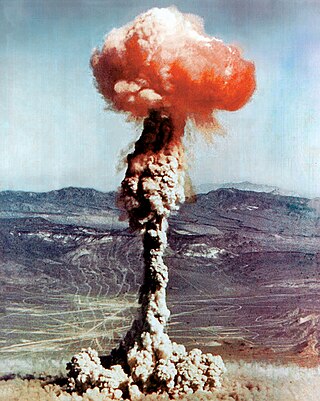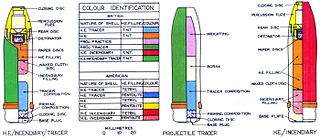Related Research Articles

A shaped charge is an explosive charge shaped to focus the effect of the explosive's energy. Different types of shaped charges are used for various purposes such as cutting and forming metal, initiating nuclear weapons, penetrating armor, or perforating wells in the oil and gas industry.
Lawrence Livermore National Laboratory (LLNL) is a federal research facility in Livermore, California, United States. The lab was originally established as the University of California Radiation Laboratory, Livermore Branch in 1952 in response to the detonation of the first atomic bomb by the Soviet Union during the Cold War. It later became autonomous in 1971 and was designated a national laboratory in 1981.

Pentaerythritol tetranitrate (PETN), also known as PENT, PENTA, TEN, corpent, or penthrite, is an explosive material. It is the nitrate ester of pentaerythritol, and is structurally very similar to nitroglycerin. Penta refers to the five carbon atoms of the neopentane skeleton. PETN is a very powerful explosive material with a relative effectiveness factor of 1.66. When mixed with a plasticizer, PETN forms a plastic explosive. Along with RDX it is the main ingredient of Semtex.

Trinity was the code name of the first detonation of a nuclear weapon. It was conducted by the United States Army at 5:29 a.m. on July 16, 1945, as part of the Manhattan Project. The test was conducted in the Jornada del Muerto desert about 35 miles (56 km) southeast of Socorro, New Mexico, on what was then the Alamogordo Bombing and Gunnery Range, now part of White Sands Missile Range. The only structures originally in the vicinity were the McDonald Ranch House and its ancillary buildings, which scientists used as a laboratory for testing bomb components. A base camp was constructed, and there were 425 people present on the weekend of the test.

Ammonium nitrate is a chemical compound with the chemical formula NH4NO3. It is a white crystalline salt consisting of ions of ammonium and nitrate. It is highly soluble in water and hygroscopic as a solid, although it does not form hydrates. It is predominantly used in agriculture as a high-nitrogen fertilizer. Global production was estimated at 21.6 million tonnes in 2017.

C-4 or Composition C-4 is a common variety of the plastic explosive family known as Composition C, which uses RDX as its explosive agent. C-4 is composed of explosives, plastic binder, plasticizer to make it malleable, and usually a marker or odorizing taggant chemical. C-4 has a texture similar to modelling clay and can be molded into any desired shape. C-4 is relatively insensitive and can be detonated only by the shock wave from a detonator or blasting cap.

The Nevada National Security Site, known as the Nevada Test Site (NTS) until 2010, is a United States Department of Energy (DOE) reservation located in southeastern Nye County, Nevada, about 65 miles (105 km) northwest of the city of Las Vegas. Formerly known as the Nevada Proving Grounds, the site was established in 1951 for the testing of nuclear devices. It covers approximately 1,360 square miles (3,500 km2) of desert and mountainous terrain. Nuclear weapons testing at the site began with a 1-kiloton-of-TNT (4.2 TJ) bomb dropped on Frenchman Flat on January 27, 1951. Over the subsequent four decades, over 1,000 nuclear explosions were detonated at the site. Many of the iconic images of the nuclear era come from the site.

Project Plowshare was the overall United States program for the development of techniques to use nuclear explosives for peaceful construction purposes. The program was organized in June 1957 as part of the worldwide Atoms for Peace efforts. As part of the program, 31 nuclear warheads were detonated in 27 separate tests. A similar program was carried out in the Soviet Union under the name Nuclear Explosions for the National Economy.

Detonation is a type of combustion involving a supersonic exothermic front accelerating through a medium that eventually drives a shock front propagating directly in front of it. Detonations propagate supersonically through shock waves with speeds in the range of 1 km/sec and differ from deflagrations which have subsonic flame speeds in the range of 1 m/sec.
Polymer-bonded explosives, also called PBX or plastic-bonded explosives, are explosive materials in which explosive powder is bound together in a matrix using small quantities of a synthetic polymer. PBXs are normally used for explosive materials that are not easily melted into a casting, or are otherwise difficult to form.

The National Ignition Facility (NIF) is a laser-based inertial confinement fusion (ICF) research device, located at Lawrence Livermore National Laboratory in Livermore, California, United States. NIF's mission is to achieve fusion ignition with high energy gain. It achieved the first scientific breakeven controlled fusion experiment on December 5, 2022, with an energy gain factor of 1.5. It supports nuclear weapon maintenance and design by studying the behavior of matter under the conditions found within nuclear explosions.
Peaceful nuclear explosions (PNEs) are nuclear explosions conducted for non-military purposes. Proposed uses include excavation for the building of canals and harbours, electrical generation, the use of nuclear explosions to drive spacecraft, and as a form of wide-area fracking. PNEs were an area of some research from the late 1950s into the 1980s, primarily in the United States and Soviet Union.

The W84 is an American thermonuclear warhead initially designed for use on the BGM-109G Gryphon Ground Launched Cruise Missile (GLCM).

The W68 warhead was the warhead used on the UGM-73 Poseidon SLBM missile. It was developed in the late 1960s at Lawrence Livermore National Laboratory.

TNT equivalent is a convention for expressing energy, typically used to describe the energy released in an explosion. The ton of TNT is a unit of energy defined by that convention to be 4.184 gigajoules, which is the approximate energy released in the detonation of a metric ton of TNT. In other words, for each gram of TNT exploded, 4.184 kilojoules of energy is released.
The Reliable Replacement Warhead (RRW) was a proposed new American nuclear warhead design and bomb family that was intended to be simple, reliable and to provide a long-lasting, low-maintenance future nuclear force for the United States. Initiated by the United States Congress in 2004, it became a centerpiece of the plans of the National Nuclear Security Administration (NNSA) to remake the nuclear weapons complex.

Pentolite is a composite high explosive used for military and civilian purposes, e.g., warheads and booster charges. It is made of pentaerythritol tetranitrate (PETN) phlegmatized with trinitrotoluene (TNT) by melt casting.

Erythritol tetranitrate (ETN) is an explosive compound chemically similar to PETN, though it is thought to be slightly more sensitive to friction and impact.
The Voitenko compressor is a shaped charge adapted from its original purpose of piercing thick steel armour to the task of accelerating shock waves. It was proposed by Anatoly Emelyanovich Voitenko, a Soviet scientist, in 1964. It slightly resembles a wind tunnel.
The Gurney equations are a set of mathematical formulas used in explosives engineering to relate how fast an explosive will accelerate an adjacent layer of metal or other material when the explosive detonates. This determines how fast fragments are released by military explosives, how quickly shaped charge explosives accelerate their liners inwards, and in other calculations such as explosive welding where explosives force two metal sheets together and bond them.
References
- ↑ Cooper, Paul W. (1996). "Chapter 4: Use forms of explosives". Explosives Engineering. Wiley-VCH. pp. 51–66. ISBN 0-471-18636-8.
- ↑ Technical Area 36 Open Detonation Unit — SUPPLEMENT 2-1 Waste Explosives Detonated at Technical Area 36 (PDF) (Report). September 1999. p. 2. Archived (PDF) from the original on 2022-10-01.
- ↑ Dobratz, B M. (1981). LLNL explosives handbook: properties of chemical explosives and explosives and explosive simulants (pdf) (Report). USA: LLNL. p. 420. doi:10.2172/6530310.